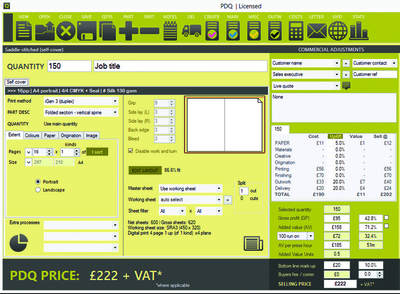Haybrooke Associates’ PDQ software makes print estimating something that the least skilled member of the company can handle.
Forget 20 a day – Haybrooke Associates’ PDQ desktop print estimating tool, likened to the ‘cleverest fag packet ever developed in a printing company’ can generate 20 print quotes in a matter of seconds.
John Roche, director of Haybrooke Associates, is the man responsible for the cigarette packet analogy. PDQ stands for Predictive Dynamic Quoting.
It is a smart little desktop tool that Mr Roche also describes as one of the industry’s best-kept secrets. It can be used as a standalone system for estimating, or be linked directly into an MIS system, so that job details from a successful estimate automatically populate job tickets and move all the way through to invoicing. Mr Roche told Digital Printer: ‘That back-of-afag- packet estimation that the sales guy did, PDQ allows you to do in total confidence.
When PDQ is fully deployed, estimators are no longer estimators, they are order creators. We have one client where the receptionist does the quotes. What remains is an instruction to a person who has to create an order in MIS.’
PDQ uses intelligent route-based algorithms to quickly calculate the most cost effective way to produce a job, based on the equipment in a print company’s factory. It also displays a CO2 calculation based on the energy consumption of the printing press, the carbon impact of the paper used and that of the delivery method. It shows values for added value percentage (selling price minus all purchases and outwork), gross profit (added value minus direct wages) and production time.
It also has a feature called Intelliprice, linked to the calculation engine, which has only recently been added. This is a rating of the overall contribution a given job will make on sales, added value, gross profit and mark up. You tell the system what your target break even numbers are for all of these key performance indicators.
When a quote is created, Intelliprice gives you a figure. If the figure is below 5, then the job is not meeting all your targets; if you, for example, increase your margin a little and reach a rating of 5 exactly, then you have met your targets; anything above 5 and that job as specified is over-performing against your targets. This is all displayed in a pleasingly visual and easy to understand way.
‘One of the hardest things for an estimator is judging whether the price you are about to give a customer will make a valid contribution to your organisation,’ Mr Roche continued. ‘When we put Intelliprice in our first customer about three months ago, they said they used to look at the margin but now they look at the Overall Job Rating more than anything else. It tells them instantly whether it’s a viable job for the business, rather than them having to work that out from all the other KPIs. We think this is a very neat addition to the solution.’
He is honest about the intent behind a tool like PDQ, that it is ‘intentionally de-skilling estimating’, adding that this is ‘not because we want estimators to lose their jobs, but because we want printers to stay in business’. While the system is fast, it is the built-in knowledge and intelligence when compared to systems that use price matrices, price lists, and templates, that he believes make it stand out, and which allow less experienced estimating minds to use it.
‘I also know that there are estimators using tools that can produce quotes in lightning quick time. But what they are really proving is how expert a user they are. PDQ allows someone that’s not an expert to do it really quickly.’
UK print companies such as Eclipse in Kettering and POS specialist Simpson Group, use PDQ as a standalone estimating tool providing instant quotes. Companies such as Anton Group and APS have integrated it into their MIS, using JDF or XML. One MIS system – Tungsten from 2b-or-not – has PDQ integrated at code level. The software also has a powerful imposition engine, which Mr Roche said some companies are using to validate the best imposition scheme.
More developments are to come with PDQ. One soon-to-be-released feature is the Volume Quoting Tool, which allows a user to process a large number of quotes, perhaps each with only a small aspect different from the rest, perhaps imported from a spreadsheet, simultaneously. It’s quick to set up and when you click for the results a progress bar shows how quickly it is working through them. ‘We timed it at 21 seconds for 100 quotes,’ said Mr Roche.
Future developments might also include elements of job ticketing and invoicing. A simple set up of PDQ costs £1950, followed by a monthly licence fee per user, up to five users.





